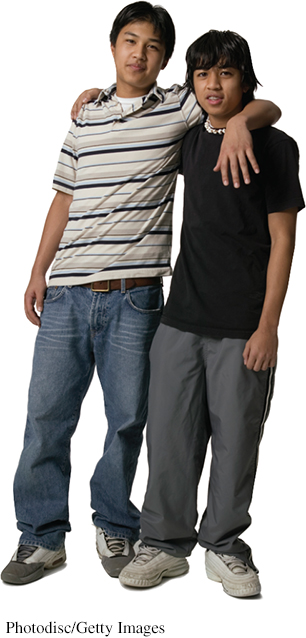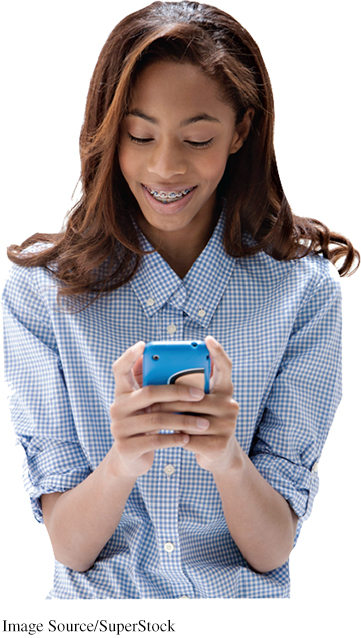9.3 The Need to Belong

LOQ 9-
Imagine yourself like the fictional Robinson Crusoe, dropped on an island . . . alone . . . for the rest of your life. Food, shelter, and comfort are yours—
Surely not. We are what the ancient Greek philosopher Aristotle called the social animal. Cut off from friends or family—
The Benefits of Belonging
Social bonds boosted our ancestors’ chances of survival. These bonds motivated caregivers to keep children close, protecting them from threats (Esposito et al., 2013). As adults, those who formed attachments were more likely to reproduce and co-
Survival also was supported by cooperation. In solo combat, our ancestors were not the toughest predators. But as hunters, they learned that eight hands were better than two. As food gatherers, they gained protection from their enemies by traveling in groups. Those who felt a need to belong survived and reproduced most successfully, and their genes now rule.
People in every society on Earth belong to groups (and, as Chapter 11 explains, prefer and favor “us” over “them”). With the need to belong satisfied by close, supportive relationships, we feel included, accepted, and loved, and our self-
Is it surprising, then, that so much of our social behavior aims to increase our feelings of belonging? To win friendship and avoid rejection, we generally conform to group standards. We monitor our behavior, hoping to make a good impression. We spend billions on clothes, cosmetics, and diet and fitness aids—
Thrown together in groups at school, at work, on a hiking trip, we behave like magnets, moving closer, forming bonds. Parting, we feel distress. We promise to call, to write, to come back for reunions. By drawing a sharp circle around “us,” the need to belong feeds both deep attachments and menacing threats. Out of our need to define a “we” come loving families, faithful friendships, and team spirit, but also teen gangs, ethnic rivalries, and fanatic nationalism.

Even when bad relationships break, people suffer. In one 16-
Children who move through a series of foster homes also know the fear of being alone. After repeated breaks in budding attachments, children may have difficulty forming deep attachments (Oishi & Schimmack, 2010). The evidence is clearest at the extremes—
No matter how secure our early years were, we all experience anxiety, loneliness, jealousy, or guilt when something threatens or dissolves our social ties. Many of life’s best moments occur when close relationships begin: making a new friend, falling in love, having a baby. And many of life’s worst moments happen when close relationships end (Jaremka et al., 2011). At such times, we may feel life is empty, pointless, and we may overeat to fill that emptiness (Yang et al., 2016). For those moving alone to new places, the stress and loneliness can be depressing. After years of placing individual refugee and immigrant families in isolated communities, U.S. agencies today encourage chain migration (Pipher, 2002). The second Syrian refugee family settling in a town generally has an easier adjustment than the first.
The Pain of Being Shut Out
Sometimes our need to belong is denied. Can you recall a time when you felt excluded or ignored or shunned? Perhaps you were unfriended or ignored online. Or perhaps others gave you the silent treatment, avoided you, looked away, mocked you, or shut you out in some other way.
ostracism eliberate social exclusion of individuals or groups.
This is ostracism—social exclusion (Williams, 2007, 2009). Worldwide, humans use many forms of ostracism—

Being shunned threatens our need to belong (Vanhalst et al., 2015; Wirth et al., 2010). Lea, a lifelong victim of the silent treatment by her mother and grandmother, described the effect. “It’s the meanest thing you can do to someone, especially if you know they can’t fight back. I never should have been born.” Like Lea, people often respond to ostracism with efforts to restore their acceptance, depressed moods, and then withdrawal. Prisoner William Blake (2013) has spent more than a quarter-
“Do we really think it makes sense to lock so many people alone in tiny cells for 23 hours a day, sometimes for months or even years at a time? . . . And if those individuals are ultimately released, how are they ever going to adapt?”
U.S. President Barack Obama, July 14, 2015, expressing bipartisan concerns about the solitary confinement of some 75,000 American prisoners
Rejected and powerless, people may seek new friends. Or they may turn nasty, as did college students made to feel rejected in one series of experiments (Gaertner et al., 2008; Twenge et al., 2001, 2007). Some students were told that a personality test they had taken showed that they were “the type likely to end up alone later in life.” Others heard that people they had met didn’t want them in a group that was forming. Still others heard good news. These lucky people would have “rewarding relationships throughout life,” or “everyone chose you as someone they’d like to work with.” How did students react after being told they weren’t wanted or would end up alone? They were much more likely to engage in self-
Ostracism is a real pain. Brain scans show increased activity in areas that also activate in response to physical pain (Lieberman & Eisenberger, 2015; Rotge et al., 2015). That helps explain another surprising finding. The pain reliever acetaminophen (as in Tylenol), taken to relieve physical pain, also lessens social pain (DeWall et al., 2010). Psychologically, we seem to experience social pain with the same emotional unpleasantness that marks physical pain. And across cultures, we use the same words (for example, hurt, crushed) for social pain and physical pain (MacDonald & Leary, 2005).
The opposite of ostracism—
The bottom line: Social isolation and rejection foster depressed moods or emotional numbness, and they can trigger aggression (Bernstein & Claypool, 2012; Gerber & Wheeler, 2009). They can put us at risk for mental decline and ill health (Cacioppo & Hawkley, 2009). But love is a natural painkiller. When feelings of acceptance and connection build, so do self-
Retrieve + Remember
Question 9.6
•How have students reacted in studies where they were made to feel rejected and unwanted? What helps explain these results?
ANSWER: They engaged in more self-
Connecting and Social Networking
LOQ 9-
As social creatures, we live for connection. Researcher George Vaillant (2013) was asked what he had learned from studying 238 Harvard University men from the 1930s to the end of their lives. He replied, “Happiness is love.” A South African Zulu saying captures the idea: Umuntu ngumuntu ngabantu—
Mobile Networks and Social Media
Look around and see humans connecting: talking, tweeting, texting, posting, chatting, social gaming, e-
At the end of 2015, the world had 7.4 billion people and more than 7 billion mobile cell-
phone subscriptions (ITU, 2016). But phone talking now accounts for less than half of U.S. mobile network traffic (Wortham, 2010). Speedy texting is not really writing, said one observer (McWhorter, 2012), but rather a new form of conversation— “fingered speech.” The typical U.S. teen with a cell phone sends 30 texts a day (Lenhart, 2015). For many, it’s as though friends are always present. Half of 18-
to 29- year- olds with a smart phone check it multiple times per hour, and “can’t imagine . . . life without [it]” (Newport, 2015; Saad, 2015). How many of us are using social networking sites? Among 2014’s entering American college students, 94 percent were (Eagan et al., 2014). With so many of your friends on a social network, its lure becomes hard to resist. Such is our need to belong. Check in or miss out.
The Net Result: Social Effects of Social Networking
By connecting like-
HAVE SOCIAL NETWORKING SITES MADE US MORE, OR LESS, SOCIALLY ISOLATED? Lonely people have tended to spend greater-


DOES ELECTRONIC COMMUNICATION STIMULATE HEALTHY SELF-
narcissism excessive self-
DOES SOCIAL NETWORKING PROMOTE NARCISSISM? Narcissism is self-
For narcissists, social networking sites are more than a gathering place; they are a feeding trough. In one study, college students were randomly assigned either to edit and explain their online profiles for 15 minutes, or to use that time to study and explain a Google Maps routing (Freeman & Twenge, 2010). After completing their tasks, all were tested. Who then scored higher on a narcissism measure? Those who had spent the time focused on themselves.
 See LaunchPad’s Video: Random Assignment for a helpful tutorial animation.
See LaunchPad’s Video: Random Assignment for a helpful tutorial animation.
Maintaining Balance and Focus
It will come as no surprise that excessive online socializing and gaming have been associated with lower grades (Chen & Fu, 2008; Kaiser Family Foundation, 2010). In one U.S. survey, 47 percent of the heaviest users of the Internet and other media were receiving mostly C grades or lower, as were just 23 percent of the lightest users (Kaiser Family Foundation, 2010).
In today’s world, each of us is challenged to maintain a healthy balance between our real-
Monitor your time. Keep a log of how you use your time. Then ask yourself, “Does my time use reflect my priorities? Am I spending more or less time online than I intended? Is my time online interfering with school or work performance? Have family or friends commented on this?”
Monitor your feelings. Ask yourself, “Am I emotionally distracted by my online interests? When I disconnect and move to another activity, how do I feel?”
“Hide” from your more distracting online friends when necessary. And in your own postings, practice the golden rule. Before you post, ask yourself, “Is this something I’d care about reading if someone else posted it?”
Page 270 © The New Yorker Collection, 2013, Liam Walsh from cartoonbank.com. All Rights Reserved.
© The New Yorker Collection, 2013, Liam Walsh from cartoonbank.com. All Rights Reserved.When studying, get in the habit of checking your phone only once per hour. Selective attention—
the flashlight of your mind— can be in only one place at a time. When we try to do two things at once, we don’t do either one of them very well (Willingham, 2010). If you want to study or work productively, resist the temptation to always be available. Disable sound alerts, vibration, and pop- ups, which can hijack your attention just when you’ve managed to get focused. (To avoid distraction, I [DM] am proofing and editing this chapter in a coffee shop without Wi- Fi.) Try a social networking fast (give it up for an hour, a day, or a week) or a time-
controlled social media diet (check in only after homework is done, or only during a lunch break). Take notes on what you’re losing and gaining on your new “diet.”Refocus by taking a nature walk. People learn better after a peaceful walk in a park, which—
unlike a walk on a busy street— refreshes our capacity for focused attention (Berman et al., 2008).
As psychologist Steven Pinker (2010a) said, “The solution is not to bemoan technology but to develop strategies of self-
Retrieve + Remember
Question 9.7
•Social networking tends to _____ (strengthen/weaken) your relationships with people you already know, and _____ (increase/decrease) your self-
ANSWERS: strengthen; increase